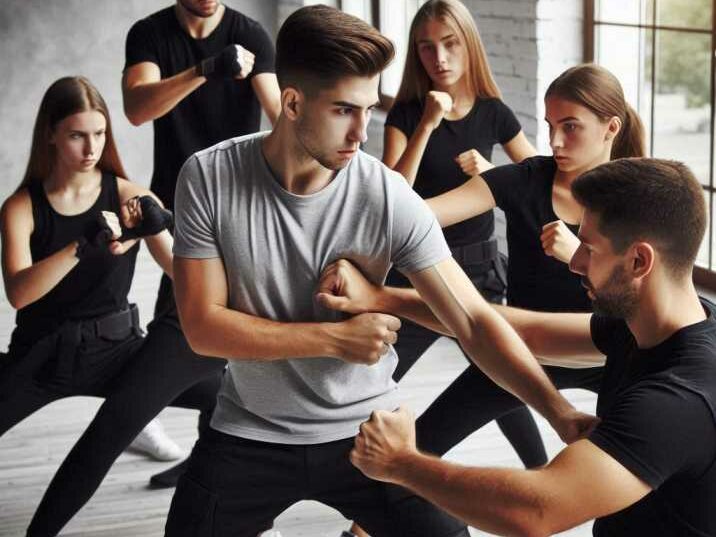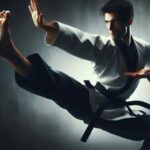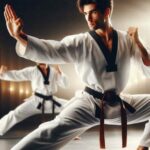Introduction
Table of Contents
Have you ever wondered what kind of fighting style can help you stay safe in dangerous situations? Krav Maga is a unique and effective self-defense system that comes from Israel. It is designed to help people protect themselves quickly and efficiently. Let’s dive into the exciting world of Krav Maga and learn what makes it so special!

Table of Contents
- What is Krav Maga?
- History of Krav Maga
- Principles of Krav Maga
- Basic Techniques in Krav Maga
- Training in Krav Maga
- Benefits of Learning Krav Maga
- Krav Maga vs. Other Martial Arts
- Frequently Asked Questions
- Conclusion
What is Krav Maga?
Krav Maga is a self-defense and fighting style that was developed in Israel. It combines techniques from boxing, wrestling, judo, and other martial arts. The main goal of Krav Maga is to teach people how to defend themselves in real-life situations as quickly and effectively as possible.
History of Krav Maga
Krav Maga was created by Imi Lichtenfeld in the 1930s. Imi was a wrestler and boxer who wanted to develop a system that could help people defend themselves during World War II. He combined his knowledge of different fighting styles to create Krav Maga, which means “contact combat” in Hebrew. The Israeli military adopted Krav Maga, and it has since spread worldwide.
Principles of Krav Maga
Krav Maga is built on several key principles:
Simplicity: Krav Maga emphasizes techniques that are straightforward and easy to grasp, making them accessible even under stress. By reducing complexity, practitioners can react swiftly and effectively in dangerous situations.
Efficiency: The core of Krav Maga is efficiency in action. Techniques are designed to neutralize threats swiftly and decisively, focusing on ending a confrontation quickly with minimal effort and movement.
Aggressiveness: Unlike many traditional martial arts, Krav Maga promotes an assertive and proactive approach to self-defense. Practitioners are trained to respond decisively to threats, using controlled aggression to gain the upper hand and ensure their safety.
Adaptability: One of Krav Maga’s strengths lies in its adaptability to various scenarios. Techniques can be modified to suit different environments, types of attackers, and levels of threat, ensuring practical application in real-life situations.
Basic Techniques in Krav Maga:
- Punches and Kicks:
- Purpose: In Krav Maga, punches and kicks are not just for striking but are aimed at causing significant damage to disable attackers swiftly.
- Techniques: Emphasizes direct, powerful strikes targeting vulnerable areas such as the groin, throat, or knees, to incapacitate opponents effectively.
- Training Focus: Practitioners train to deliver these strikes with speed, accuracy, and force, ensuring they can respond decisively in threatening situations.
- Defensive Moves:
- Purpose: Defensive techniques in Krav Maga are crucial for protecting oneself while simultaneously creating opportunities to counter-attack or escape.
- Techniques: Includes blocks, deflects, and redirections to neutralize incoming attacks, followed by immediate, controlled responses to regain control of the situation.
- Training Focus: Focuses on reflexive movements that can be executed quickly under stress, often integrating offensive maneuvers to subdue attackers effectively.
- Ground Fighting:
- Purpose: Ground fighting techniques are essential for managing situations where practitioners are forced onto the ground, ensuring they can defend and escape.
- Techniques: Covers strategies for maintaining leverage, controlling opponents, and transitioning to advantageous positions to stand up or continue fighting effectively.
- Training Focus: Emphasizes situational awareness, defensive positioning, and rapid response techniques tailored for confined or disadvantageous spaces.
- Weapon Defense:
- Purpose: Krav Maga equips practitioners with skills to disarm and neutralize attackers armed with various weapons, prioritizing safety and swift action.
- Techniques: Teaches methods to deflect, disarm, and control weapons such as knives, sticks, or firearms, emphasizing decisive and aggressive responses.
- Training Focus: Includes scenario-based drills to simulate realistic threats, ensuring practitioners can react effectively under pressure while minimizing risks to themselves and others.
Training in Krav Maga:
- Warm-Up Exercises:
- Purpose: Prepares the body physically and mentally for the demands of Krav Maga training, reducing the risk of injury and optimizing performance.
- Activities: Includes dynamic stretching, cardiovascular exercises, and mobility drills tailored to enhance flexibility, endurance, and coordination.
- Duration: Typically lasts 10-15 minutes, varying based on the intensity and focus of the training session.
- Technique Practice:
- Purpose: Refines fundamental techniques and builds muscle memory, ensuring practitioners can execute movements effectively under stress.
- Methods: Involves repetitive drills focusing on punches, kicks, defensive maneuvers, and ground fighting techniques, progressively increasing in complexity and speed.
- Feedback: Instructors provide feedback on technique, posture, and timing to correct errors and improve proficiency.
- Sparring:
- Purpose: Simulates real-life confrontations, allowing practitioners to apply techniques learned in training against resisting opponents in a controlled environment.
- Types: Includes light-contact and full-contact sparring sessions, each serving different purposes to develop timing, distance management, and decision-making skills.
- Safety Measures: Participants wear protective gear and follow rules to ensure safety while maintaining the realism of the encounter.
- Cool-Down:
- Purpose: Facilitates recovery, reduces muscle tension, and promotes flexibility after intense physical exertion during training.
- Activities: Focuses on static stretching, deep breathing, and relaxation techniques to enhance circulation, decrease heart rate, and promote overall relaxation.
- Benefits: Helps prevent injuries, promotes muscle recovery, and prepares practitioners mentally and physically for subsequent training sessions or daily activities.
Benefits of Learning Krav Maga:
- Self-Defense Skills:
- Importance: Krav Maga equips individuals with practical techniques to defend against various threats in real-life scenarios, fostering a sense of security and preparedness.
- Training Impact: Focuses on situational awareness, quick decision-making, and effective use of strikes and defensive maneuvers to neutralize attackers.
- Community Safety: Enables practitioners to protect themselves and others, promoting a safer environment through enhanced personal security skills.
- Physical Fitness:
- Improvement Areas: Krav Maga training incorporates intense physical exercises that enhance strength, agility, speed, and cardiovascular endurance.
- Functional Training: Exercises are designed to mimic the dynamic movements and exertions required during self-defense situations, improving overall physical conditioning.
- Health Benefits: Regular practice contributes to weight management, increased energy levels, and improved overall health, supporting long-term fitness goals.
- Confidence:
- Psychological Empowerment: Mastery of Krav Maga techniques instills confidence in handling threatening situations, bolstering self-assurance and resilience.
- Emotional Benefits: Reduces fear and anxiety associated with potential dangers, promoting a proactive mindset and assertive behavior in daily life.
- Social Interaction: Builds camaraderie and mutual support within the Krav Maga community, fostering a sense of belonging and empowerment among practitioners.
- Stress Relief:
- Physical Activity Benefits: Engaging in Krav Maga workouts releases endorphins, alleviating stress and tension accumulated from daily challenges.
- Cathartic Release: Provides a healthy outlet for pent-up emotions and frustrations, promoting mental clarity and emotional well-being.
- Mindfulness: Focuses attention on the present moment during training, promoting relaxation and reducing the impact of stressors outside the training environment.
Krav Maga vs. Other Martial Arts:
- Practicality:
- Real-Life Application: Krav Maga prioritizes techniques that are effective in real-world self-defense scenarios, emphasizing practicality over traditional or sport-focused martial arts.
- Scenario-Based Training: Simulates common attack situations and environments to prepare practitioners for unpredictable and potentially dangerous encounters.
- Adaptability: Techniques evolve to address modern threats, ensuring relevance and effectiveness in contemporary self-defense contexts.
- Speed:
- Execution Focus: Techniques are streamlined and optimized for rapid deployment, minimizing reaction time and maximizing effectiveness against assailants.
- Combat Efficiency: Emphasizes swift and decisive action to neutralize threats before they escalate, reflecting the urgency of real-life self-defense situations.
- No Rules:
- Combat Realism: Krav Maga training acknowledges the absence of rules or restrictions in genuine self-defense encounters, preparing practitioners mentally and physically for unpredictable confrontations.
- Versatility: Adapts to varied attack scenarios and multiple assailants, focusing on survival and escape strategies rather than adherence to competitive rules or traditions.
- Legal Awareness: Emphasizes proportionate response and ethical considerations in self-defense, promoting responsible use of skills in accordance with legal guidelines.
Conclusion
Krav Maga is an incredible self-defense system that teaches you how to protect yourself in real-life situations. With its roots in Israel, Krav Maga is now practiced worldwide and is known for its simplicity, efficiency, and adaptability. Whether you want to improve your self-defense skills, get fit, or boost your confidence, Krav Maga has something to offer everyone.
Frequently Asked Questions
Is Krav Maga suitable for kids?
Yes, there are special Krav Maga classes designed for children to help them learn self-defense in a safe environment.
How long does it take to learn Krav Maga?
It varies, but many people start feeling confident in their skills after a few months of regular training.
Do I need to be very fit to start Krav Maga?
No, Krav Maga is for everyone, and you can start at any fitness level.
Can Krav Maga be used in competitions?
Krav Maga is not typically used in competitions because it focuses on self-defense rather than sport.
Is Krav Maga effective against multiple attackers?
Yes, Krav Maga teaches techniques to handle multiple attackers and escape safely.
Image Descriptions and Placement
- Image 1: Krav Maga Training Session
- Description: A group of students practicing Krav Maga techniques with an instructor.
- Alt Text: “Krav Maga Training”
- Title: “Krav Maga Training Session”
- Placement: Near the “Training in Krav Maga” section.
- Image 2: Krav Maga Defensive Move
- Description: A student practicing a defensive move against an attacker.
- Alt Text: “Krav Maga Defense”
- Title: “Krav Maga Defensive Move”
- Placement: Near the “Basic Techniques in Krav Maga” section.


